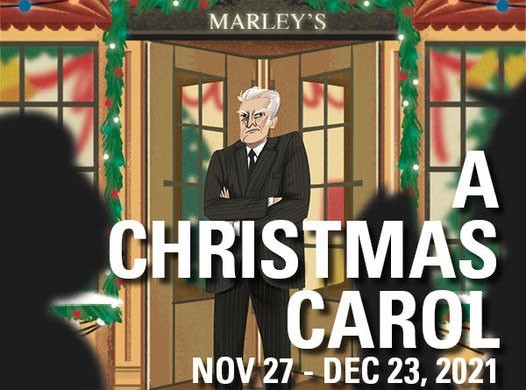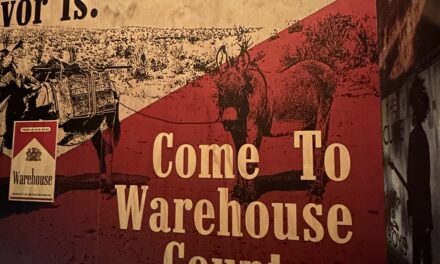“My nostalgia, however, may be bruised beyond recognition”

Review by Douglas MacDonald
There was a string of years in my childhood where every Christmas Eve my parents would take me and my brothers to see A Christmas Carol at the Citadel Theatre. On the drive home, de-touring down Candy Cane Lane, we would gush about the magic of the play – how it brought the spirit of Christmas to life.
The memory always warmed my heart, and so, I was full of nostalgia on December 3, when my girlfriend, Angela, and I went to watch A Christmas Carol at the prestigious Citadel Theatre. We were reminded that donations from A Christmas Carol seasonally raise $1.2 million for the food bank, so if you’re going, keep a generous heart in mind.
In 2019, after running the show – true to the Charles Dickens classic – successfully for 19 years, the Citadel decided to revamp A Christmas Carol. Their former production had stayed loyal to the late author’s novella, which, first published in 1843, was a sharp rebuke of the social inequity of Victorian era London, England.
The latest version, written by David Van Belle and directed by Daryl Cloran, takes place in 1950’s North America. It altered enough to upset my nostalgia, and not enough for it to be worthy of the modernisation.
We all settled in our seats. Hushed anticipation flooded the theatre as the lights went down before the first act of A Christmas Carol. Maclab Theatre was pitch black when the choir singers began to hauntingly harmonize ‘Carol of the Bells’.
The stage lights swelled. Dressed in Victorian era garb, the choir sung mellifluously until the infamous miser, Ebenezer Scrooge (Ted Dykstra), hobbled across the stage in a wide-lapelled, pinstriped-suit and overcoat, hollering: “Take off those ridiculous clothes – it’s not Old-Timey England!” It was a clever way to introduce the setting; however, I was immediately jarred by the portrayal of Scrooge: he sounded like a curmudgeon in suspenders, grumbling from a dilapidated porch in Sudbury, Ontario. Angela and I squeezed hands in discomfort at the depiction.
The set of Maclab’s thrust stage, which stretches outward into the audience, gives the crowd a wrap-around viewing. It was brilliantly designed (Cory Sincennes) with brick and stone backdrops that flawlessly weaved in and out of scenes. The flow was impeccable.
Centre stage wore the omnipresent clock like a bow tie – fixed forefront under the bandstand, which was built into an upstairs compartment. The small opening to see the live band was impossible to view unless you were seated directly in the middle of the audience. It was a nice idea, but poorly executed as I could only watch the one bobbing head of the pianist while I heard a stand-up bass, drums, and myriad brass instruments, all of which were out of sight from my section (and many others).
The music direction (Mishelle Cutler) was terrific and brought Christmas alive – sadly, the sound mix was a mess. There was plenty of singing – I enjoyed the arrangement of the classic Christmas songs – but some voices came through louder than others, while the music overpowered various performers. More than once, the microphones cut out completely, jolting me out of the play. I was very aware of Angela’s hand gripping my leg in excruciating angst.
The set design kept the magic alive through the supernatural powers of the Maclab theatre – exemplified, mainly, through the spirits. I was stunned and terrified several times by the ghost of Marley (Julien Arnold) and astounded by the sleight-of-hand that the Maclab theatre procures. Flawlessly, the set shocked with its efficacy; I kept wondering: how the hell did they do that?
The ghost of Christmas Past (Lilla Solymos) continued the astonishing stage effects where she would malevolently wreck the stage with a wave of her hand, and then, benevolently take ‘Ben’ Scrooge by the hand and guide him out a snowy window. Her costume design (Cory Sincennes) was entrancing; most notable was a line of lit candles on her shoulders. Lilla’s performance was a refreshing balance between gracefully angelic and fiercely condemning.
While she showed Scrooge his past, a wonderful dance number at Fezziwig’s party featured a congenial banjo solo by Fezziwig (also, Julien Arnold). The Christmas energy onstage was enormous and enthralling; the choreography (originally: Laura Krewski; currently: Gianna Vacirca), was larger than life and entirely engrossing.
I was taken out of the play again as Scrooge ogled his young lover, Bell (Daniela Fernandez), and lecherously mutters, “I can see why I fell for her.” I cared less for the miserly sybarite’s redemption after his lascivious display.
Just before intermission, an incredible bit of stage magic prepared us for the second act.
Scrooge slid onstage, still in his bedclothes. The bell tolled two, and the ghost of Christmas Present (John Ullyatt) exploded onstage. Dressed like a jazz musician from the 1940’s in Christmas green and red, he reminded me of Robin Williams’ genie from Aladdin, when he is released from the lamp – all positivity and hope – with a hint of melancholic longing. The song and dance he performed suffered when he missed his cue by a hair, though it was still entertaining and energizing.
Fred (Oscar Derkx), Scrooge’s nephew, was convivial, as he hosted his annual party. The costumes were indicative of the 1950’s, which I am familiar with, mostly, through film and television caricatures: young people in fancy jackets and pompous pompadours grooved with caged abandon.
Another dance party enlivened the stage. Christmas Present switched out wigs to show his ageing, and by the end of his stead, he was gray-haired and weary. Tim (not Tiny?), following one coughing fit, strode centre stage for a song, where they embellish another coughing fit. Angela’s fingernails dug into my leg, and I anxiously held my breath until the scene finally ended.
My childhood nostalgia was most disappointed at the climax. I remember the Ghost of Christmas Yet-To-Come (Braydon Dowler-Coltman) as a colossal demon looming over me as I huddled into the furthest recesses of my seat. I remembered the black cloaked spectre being larger than life. It turns out that they had shrunk the costume from 20ft to 12ft. It wasn’t just my size or my unreliable memory – they had scaled down the spirit. Also, Scrooge rushed his questioning of the phantom so that it was continuously nodding, giving the ghost an air of agreeability, the obverse of its nature.
At the end, instead of a repentant hand wiping snow off a gravestone, Scrooge watched as his bedridden corpse was carried out by a throng of devils. I wished the reaped young actor that played the dying Scrooge would have held his arm over his face, instead of me witnessing an adolescent being carried offstage, poorly disguised as an aged Scrooge. The magic was stolen at a crucial moment.
It has been debated whether A Christmas Carol is a Christian allegory; this rendition nails the tale to a cross at the finale with godly gaudiness. Also, the materialistic elements of Scrooge’s redemption impose themselves in the denouement and provoke a stark contrast to the gratitude of First Nations People’s homeland which is announced at the start of the play.
Maclab’s thrust stage is an integral component of A Christmas Carol. Many moments worked, and several situations suffered. This rendition of the drama was impressive and beautiful, but ultimately disappointing. Like fireworks in a snowstorm, it had the flare, but was overcast by a blizzard of shortcomings. Hopefully, by New Year, my thigh will be healed of the bruises brought on by Angela’s tightly gripped fingernails. My nostalgia, however, may be bruised beyond recognition.
A Christmas Carol
Citadel Theatre
9828 101A Ave.
780-425-1820
see also Kirsten Dika’s edmontonscene review


